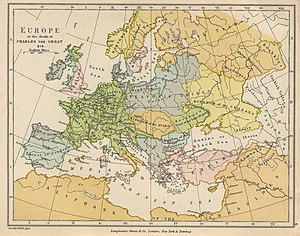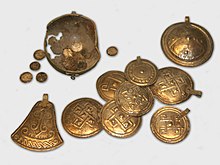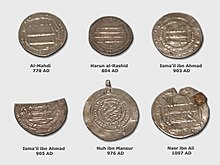This is an old revision of this page, as edited by Nug (talk | contribs) at 02:40, 7 November 2007 (Capitalisation). The present address (URL) is a permanent link to this revision, which may differ significantly from the current revision.
Revision as of 02:40, 7 November 2007 by Nug (talk | contribs) (Capitalisation)(diff) ← Previous revision | Latest revision (diff) | Newer revision → (diff)
Estonian viking expeditions (Estonian: Eesti viikingid, Norwegian: Vikinger fra Estland) appear in history in Icelandic Sagas, in Heimskringla, in various different legends and other sources. Although vikings were predominantly men from the areas now known as Denmark, Sweden and Norway there are mentions in the sagas of Finns, Sami and Estonians among them.
History places these plundering seafarers, belonging to Finnic tribes thought to be ancestors of the modern Estonians, along the eastern shores of the Baltic Sea. During the Viking era this region was known to the Scandinavians as Estland, which later became the modern name of the country Estonia in the Germanic languages. The Vikings from Estonia originated mainly from Saaremaa (Latin: Osilia, in modern day Estonia) and Courland (Latin: Curonia, in modern day Latvia).
The Osilians, a Finnic tribe inhabiting the eastern Baltic shores, are first mentioned as early as the 2nd century BC in Ptolemy's Geography III. The first reliable mention of the Curonians is from the 9th century AD by Bishop Rimbert, the biographer of St. Ansgarius. At about the same time, Nestor the Chronicler mentions the Ests, or Estonians, under the name of Chuds.
Battles and Raids
Saxo Grammaticus describes the Curonians and Estonians as participating in the Battle of Bråvalla on the side of the Swedes against the Danes, who were aided by the Livonians and the Wends of Pomerania. It is notable that Baltic tribes — ie, the Letts and Lithuanians — are not mentioned by Saxo as partaking in the fight.
Snorri Sturluson relates in his Ynglinga saga how the Swedish king Ingvar (7th century), the son of Östen and a great warrior, who was forced to patrol the shores of his kingdom fighting Estonian pirates. The saga speaks of his invasion to Estonia where he fell in a battle against the men of Estland who had came down with a great army. After the battle King Ingvar was buried close to the seashore in Estonia and the Swedes returned home.
According to Heimskringla sagas, in the year 967 the Norwegian Queen Astrid escaped with her son Olaf Tryggvason from her homeland to Novgorod, where her brother Sigurd held an honoured position at the court of Prince Vladimir. On their journey, Estonian vikings raided the ship, killing some of the crew and taking others into slavery'. Six years later, when Sigurd Eirikson traveled to Estonia to collect taxes on behalf of Valdemar, he spotted Olaf on a market and paid for his freedom.
A battle between Estonian and Icelandic vikings in Saaremaa is described in Njál's saga as occurring in 972 AD.
About 1008 Olaf the Holy, later king of Norway, landed on Saaremaa. The Osilians, taken by surprise, had at first agreed to pay the demanded Olaf, but then gathered an army during the negotiations and attacked the Norwegians. Olaf nevertheless won the battle.

Around the year 1030 a Swedish Viking chief called Freygeirr may have been killed in a battle on Saaremaa.
According to the Novgorod Chronicle, Varyag Ulf (Uleb) from Novgorod was crushed by Estonians in a sea battle close to the town of Lindanise in 1032.
The town of Tarbatu, conquered by Yaroslav the Wise in 1031, was liberated in the spring of 1061 by joint forces from Saaremaa and Ugandi. The Osilians gathered their fleet to Lake Peipsi and were victorious over the Novgorod infantry of Duke Isaslav near Pskov .
From the 12th century, chroniclers' descriptions of Estonian, Osilian and Curonian raids along the coasts of Sweden and Denmark become more frequent.
The Chronicle of Henry of Livonia describes a fleet of sixteen ships and five hundred Osilians ravaging the area that is now southern Sweden, then belonging to Denmark. In the XIVth book of Gesta Danorum, Saxo Grammaticus describes a battle on Öland in 1170 in which the Danish king Valdemar I mobilised his entire fleet to curb the incursions of Couronian and Estonian pirates.

Perhaps the most renowned raid by Estonian pirates occurred in 1187, with the attack on the Swedish town of Sigtuna by Finnic raiders from Karelia, Couronia or Estonia. Among the casualties of this raid was the Swedish archbishop Johannes. The city remained occupied for some time, contributing to the decline as a center of commerce in the 13th century in favor of Uppsala, Visby, Kalmar and Stockholm.
The Livonian Chronicle describes the Estonians as using two kinds of ships, the piratica and the liburna. The former was a battleship, the latter mainly a merchant ship. A piratica could carry approximately 30 men and had a high prow shaped like a dragon or a snakehead as well as a quadrangular sail.
Viking-age treasures from Estonia mostly contain silver coins and bars. Compared to its close neighbors, Estonia has the richest finds of Viking treasures after Gotland in Sweden. This strongly suggests that Estonia was an important transit country during the Viking era.
The Varbola Stronghold was the largest circular rampart fortress and trading center built in Estonia at the time.

Archeology
Estonia constitutes one of the richest territories in the Baltic for hoards from the 11th and the 12th centuries. The earliest coin hoards found in Estonia are Arabic Dirhams from the 8th Century. The largest Viking-Age hoards found in Estonia have been at Maidla and Kose. Out of the 1500 coins published in catalogues, 1000 are Anglo-Saxon.
Decline
With the rise of centralized authority along with a bolstering of coastal defense in the areas exposed to the viking, the viking raids became more risky and less profitable. With the growing presence of Christianity and the rise of kings and a quasi-feudal system in Scandinavia, these raids ceased entirely. By the 11th century, the Scandinavians are frequently chronicled as overpowering the vikings from the eastern shores of the Baltic Sea, which would eventually lead to German, Danish and Swedish participation in the Northern crusades and the Scandinavian conquest of Estonia.
The east Baltic world would be transformed by military conquest. First the Livs, Letts and Estonians, then the Prussians and the Finns underwent defeat, baptism, military occupation and sometimes extermination by German, Danish and Swedish forces.
Notes
- A History of Pagan Europe by Prudence Jones; on page 166; ISBN 0415091365
- Nordic Religions in the Viking Age by Thomas A. Dubois; on page 177;ISBN 0812217144
- Template:No iconOlav Trygvassons saga at School of Avaldsnes
- Heimskringla; Kessinger Publishing (March 31, 2004); on Page 116;ISBN 0766186938
- http://books.google.com/books?id=GgDaAAAACAAJ&dq A Brief History of the Vikings by Jonathan Clements; p.12; ISBN 0786715995
- The Estonian Vikings (Montreal: Practical Handbooks, 1981, ISBN 0906967406) by Edgar V. Saks
- A History of Pagan Europe By Prudence Jones, Nigel Pennick; p.195 ISBN 0415091365
- The Forgotten Republics By Clarence Augustus Manning
- ^ Pre- and Proto-historic Finns by John Abercromby p.141
- Heimskringla; 36. OF YNGVAR'S FALL
- Through Past Millennia: Archaeological Discoveries in Estonia
- The raid on Sigtuna
- Estonian Collections : Anglo-Saxon, Anglo-Norman and later British Coins; ISBN 0197262201
- The Northern Crusades: Second Edition by Eric Christiansen; p.93; ISBN 0140266534